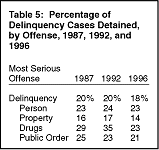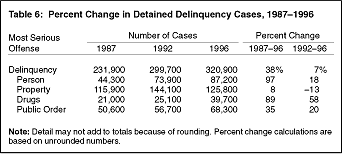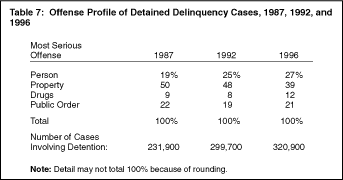|
Juvenile courts sometimes hold youth in secure detention facilities during court processing. Depending on the State’s detention laws, the court may decide detention is necessary to protect the community from a juvenile’s behavior, to ensure a juvenile’s appearance at subsequent court hearings, or to secure the juvenile’s own safety. Detention may also be ordered
for the purpose of evaluating the juvenile.
Juveniles were held in detention facilities at some point between referral to court intake and case disposition in 18% of all delinquency cases disposed in 1996 (table 5). Property offense cases were least likely to involve detention; drug or person offense cases were most likely to involve detention. Detention was involved in 14% of property offense cases, 23% of both drug and person offense cases, and 21% of public order offense cases.
The proportion of delinquency cases involving detention changed little between 1987 and 1996. During this 10-year time period, the use of detention ranged between 18% and 23%, peaking in 1990. The same general pattern was seen in each of the four major offense categories. With the exception of drug law violation cases, use of detention fluctuated within a 5- to 7-percentage point range, peaking in 1990. The use of detention for drug law violation cases also peaked in 1990, but showed a wider variation: from 38% in 1990 to 23% in 1996, a 15-point change.
The number of delinquency cases in which juveniles were detained increased 38% between 1987 and 1996, rising from 231,900 to 320,900 (table 6). Increases occurred in all offense categories, with person offense cases showing the greatest increase. Between 1987 and 1996, the number of person offense cases in which youth were detained increased 97%; the use of detention increased 89% in drug offense cases, 35% in public order offense cases, and 8% in property offense cases. During the more recent 5-year period from 1992 to 1996, however, the number of property cases in which juveniles were detained declined 13%.
Although detention was least likely in property offense cases in 1996, property offenses accounted for 39% of all delinquency cases involving detention, because they represented the largest share of juvenile court caseloads (table 7). Person offense cases accounted for 27% of cases involving detention, public order offense cases accounted for 21%, and drug law violation cases accounted for 12%. Between 1987 and 1996, the offense characteristics of delinquency cases involving detention changed somewhat, with person offenses and drug law violations accounting for larger proportions of detentions, and property offenses representing a smaller share in 1996 than in 1987 (39% compared with 50%).
|


